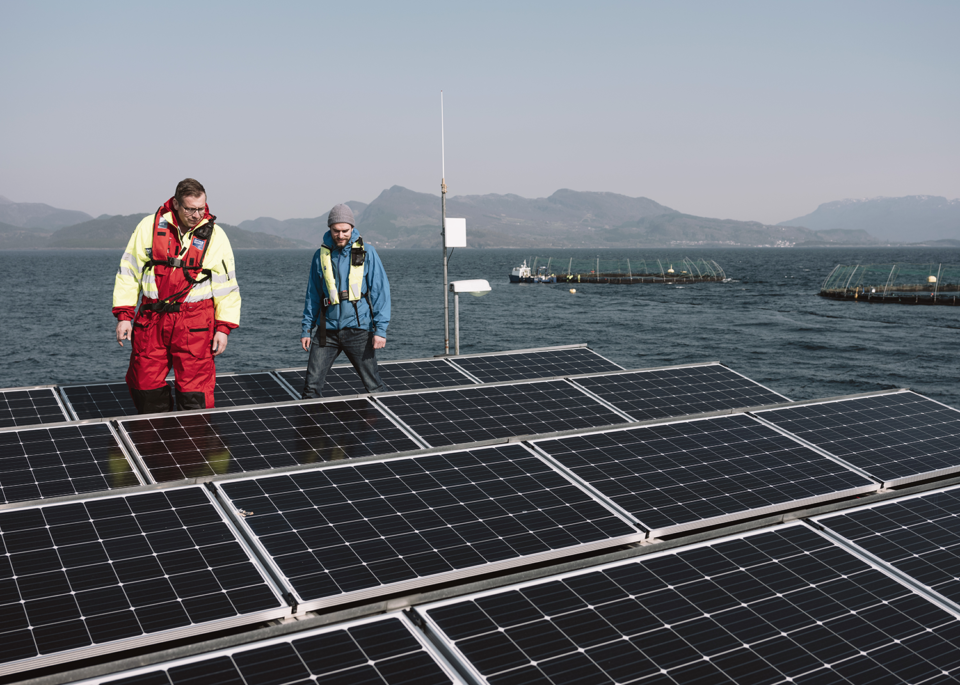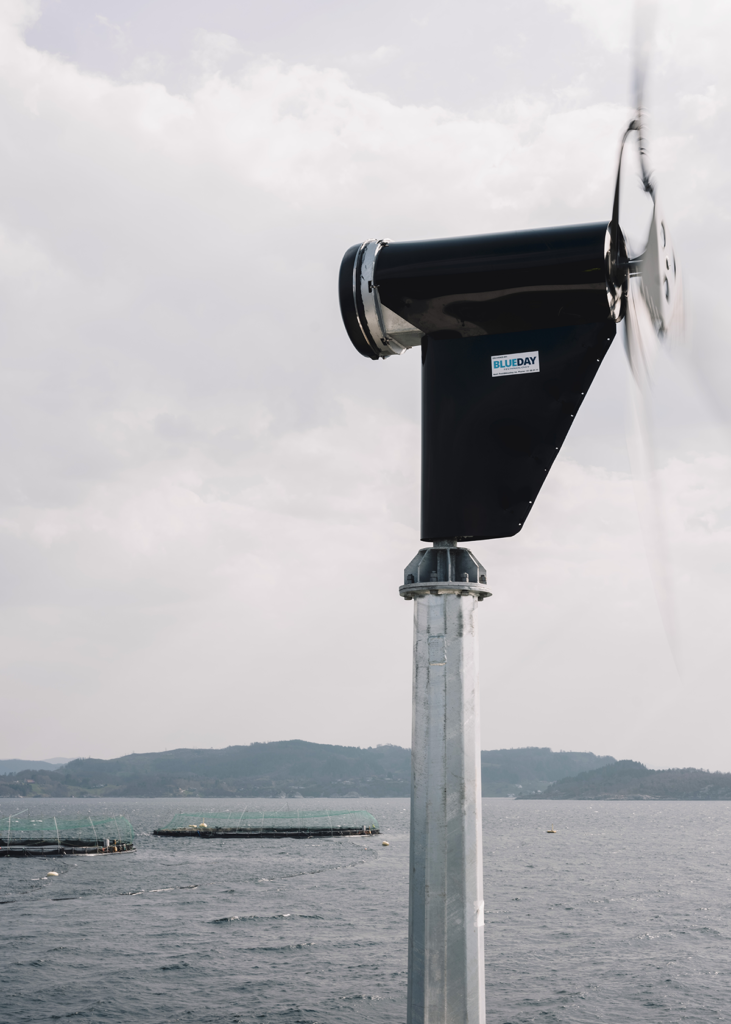… costs, extreme geographies, intermittency, unfavorable weather and other challenges? Experts say to look at ways to reduce demand first.

Aquaculture relies on energy. And with this dependence on energy comes the responsibility of ensuring that it’s used efficiently with minimal environmental impact. Some farms are now investigating this with the help of renewable energy.
Norwegian firm Moss Maritime is developing a floating solar project to power small remote islands, utility grids, oil and gas operations and fish farms. It’s a potential fit for ambitious Norwegian companies aiming to operate massive offshore salmon farms, sited many miles from shore.
“Farms located far out at sea will consume more energy and connecting them to an onshore electricity grid will become increasingly challenging,” Alexander Minge Thøgersen, VP-engineering at Moss Marime told the Advocate. “Nevertheless, offshore fish farms need power for their operations and must be able to provide clean power in remote locations. We believe there may be a potential market for renewable energy in Norway and are looking at how it could be integrated.”
Moss Maritime’s project is based on a concept that’s designed for easy fabrication, transportation and installation. It will include several floating structures, a conventional mooring system and solar panels that will be towed out to a farm site. Hopes are high that it will positively impact fish farms’ environmental footprints and provide cheaper power.
“Farms will have to be designed to receive power from renewable energy sources,” said Thøgersen. “How exposed they are, and how much energy they require, will also come into play. They shouldn’t have to make significant adjustments, but this will depend on their existing power supply, such as whether they have sea cables or generators. The major challenge will be to develop a concept that’s robust and competitive with alternative solutions but we’re focusing on this through an ongoing development project with Norwegian energy firm Equinor.”
Following a simplified model test at the Norwegian University of Science and Technology (NTNU) in Trondheim, Moss Maritime will be conducting a more extensive test on motion behavior. The project’s development phase finishes at the end of this year, and a full-size version will hopefully be demonstrated next year.
Renewable energy solutions are likely to significantly cut emissions on a fish farm, according to Helleik L. Syse of the University of Stavanger in Norway. Relying on multiple sources, for example a combination of wind turbines and photovoltaic panels with a diesel generator as backup, is the best way to guarantee a stable system, he said.
“In the Northern and Southern Hemispheres there will normally be enough sun in the spring and summer but not enough in the fall and winter,” said Syse. “However, the average wind speed is normally higher then, so combining wind and solar would ensure fairly stable energy production year-round.”
“But there will be days or weeks with almost no sun and wind, so to tackle those periods one could install batteries, which have dropped substantially in price and will continue to do so,” he continued. “Keeping a diesel generator as back up is good and often cost-effective. In future there may also be commercially available wave energy converters, which could add a third source of renewable energy generation.”

Professor Dave Little of the University of Stirling in the UK believes that there will be many interesting drivers when it comes to renewable energy, leading to a significant level of sustainable intensification. The suitability of a renewable energy system, however, depends on the amount of available sunlight, amount of energy a farm requires and location, he said.
“A farm may be a remote offshore facility that’s a long way from the grid or require a certain amount of energy so there will be different contexts requiring different solutions. But as soon as your basic energy source becomes green – a small unit connected to wave power or offshore wind power – you’re getting there,” he said.
A combination of aquaculture and renewable energy could also bring economic benefits to both sectors. Dr. Maurizio Collu is an associate professor in offshore renewable energy systems at the University of Strathclyde, UK. His work on offshore, multi-purpose platforms (MPPs) – offshore systems designed to serve the purposes of more than one offshore industry – has shown that designing renewable energy systems around a large aquaculture facility is technologically and economically feasible.
“The main advantage of MPPs is the possibility of sharing capital and operational costs,” he said. “A floating support structure, which constitutes a large part of capital costs, can be used as support for wind turbines, wave energy devices or tidal turbines, as breakwater for aquaculture cages or to install monitoring systems. An example of sharing operational costs might be the possibility of sharing personnel and technicians.”
MPPs are still being tested. But Collu sees no major hurdles, provided that a thorough approach has been adopted at the start of system design. He and his colleagues are currently talking to companies that have battery storage systems to complement diesel generators. Their next step is to combine battery storage with small wind turbines or solar panels.
Syse agrees that energy storage is key. One option is compressed air storage for offshore farms that use compressed air, he said, but this may be expensive to install. Batteries – preferably lithium ion (Li-Ion) batteries if energy demand is low/medium (less than 100 kW) – are likely to be cheaper, he believes, but enough space, fire safety and investments costs may make it harder to store sufficient energy.
The benefits of renewable energy are also likely to be significant in light of consumer sensitivity toward food production. With more companies claiming that their products are made with 100 percent renewable energy, aquaculture may benefit commercially from this type of green label. Secondly, with increasing pressure to install cages further offshore, MPPs could also be key.
But obtaining renewable energy is not without challenges, said Syse.
“Intermittency is probably the biggest issue, but this can be solved by shifting the energy load, installing storage and/or having backup generation,” he said.
“For MPPs, the major obstacle is from a legal or social standpoint,” said Collu. “We have legal frameworks for the installation of an offshore wind turbine, aquaculture system or offshore oil and gas system but not for MPPs.”
Farms’ interest in renewable energy may be rising but Syse says that it’s also important for them to reduce their energy use first. Many farms overlook this and jump directly into figuring out how to produce the energy that they currently need, he said.
“Heating can be reduced by installing a heat pump. Shorter feeding hoses could reduce the energy needed to blow feed pellets out to the cages. Less unnecessary transport or switching to electric boats could also be considered,” he said.
“Reducing energy use depends on how energy-intensive a farm is and that comes down to design. There is no replacement for good design whatever the source of energy. It also depends on your system and the value of your product,” said Little.
Collu believes that the market for renewable energy within aquaculture is likely to grow. He envisions innovative solutions along the way.
“With increasing awareness and sensitivity toward global warming, carbon emissions and sustainability, and considering the substantial technological progress of wind, solar and battery storage systems, it’s not a question of if but of when aquaculture will embrace renewable energy to access new fields and become more sustainable and green,” he said.
Follow the Advocate on Twitter @GAA_Advocate
Now that you've finished reading the article ...
… we hope you’ll consider supporting our mission to document the evolution of the global aquaculture industry and share our vast network of contributors’ expansive knowledge every week.
By becoming a Global Seafood Alliance member, you’re ensuring that all of the pre-competitive work we do through member benefits, resources and events can continue. Individual membership costs just $50 a year. GSA individual and corporate members receive complimentary access to a series of GOAL virtual events beginning in April. Join now.
Not a GSA member? Join us.
Author
-

Bonnie Waycott
Correspondent Bonnie Waycott became interested in marine life after learning to snorkel on the Sea of Japan coast near her mother’s hometown. She specializes in aquaculture and fisheries with a particular focus on Japan, and has a keen interest in Tohoku’s aquaculture recovery following the 2011 Great East Japan Earthquake and Tsunami.
Related Posts

Intelligence
Octopus aquaculture – unethical or the next Big Thing?
A team of scientists recently made the case against octopus farming, but others believe in its potential. What lies behind this emerging aquaculture opportunity?

Innovation & Investment
Japan hopes aquaculture can save bluefin tuna
Bluefin tuna may be the most prized fish in the ocean. If hon-maguro sashimi is to remain chic, closed-cycle aquaculture may help keep it on menus.

Intelligence
In Japan, tiger puffers find themselves in hot water
A technique to farm tiger puffers in hot spring water was invented to revitalize the town of Nasu-karasuyama and is now spreading to other areas of Japan.

Innovation & Investment
Technology allowing aquaculture to do social distancing
Data tools and remotely operated feeding systems are just a couple ways aquaculture is accomplishing social distancing during the coronavirus pandemic.

